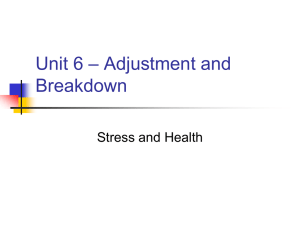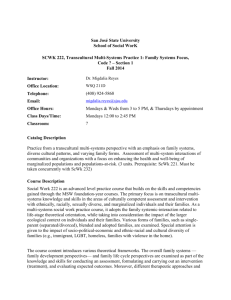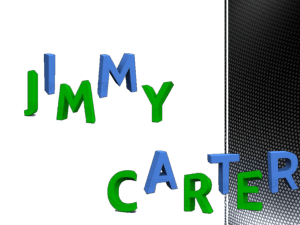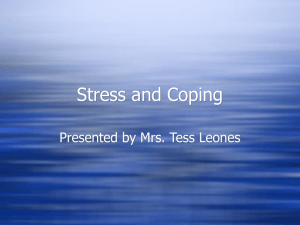CARE OF FAMILIES
advertisement
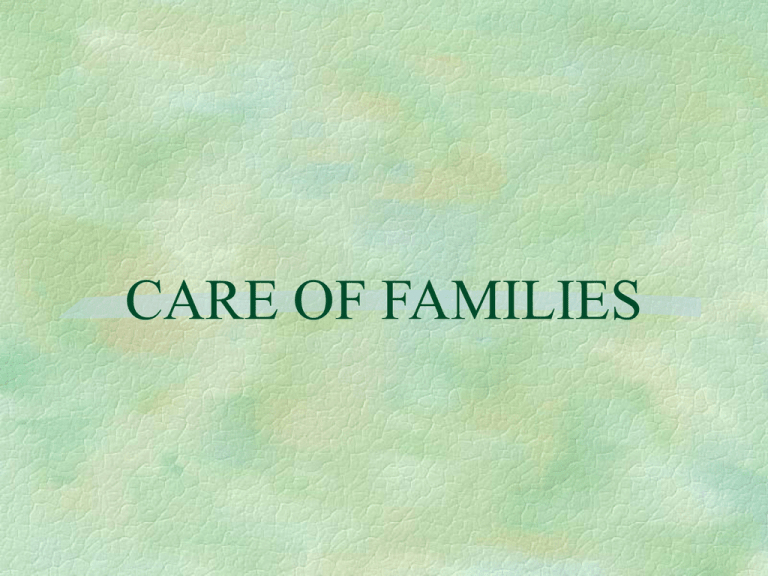
CARE OF FAMILIES Definition of Family A social system composed of “two or more persons who are joined by bonds of sharing and emotional closeness and who identify themselves as being part of the family” (Friedman, 1998, p. 9). Types of Families - 1 Nuclear conjugal family Nuclear dyad family Dual earner family Extended family Types of Families - 2 Single-parent family Step-family (blended family) Binuclear family Cohabiting family Types of Families - 3 Gay or lesbian family Communal family Foster family Skip generation family Theoretical Approaches to Family Nursing Systems models Family development models Structural-functional models Family Systems Models System: The family (focal system) Subsystems: Family members Suprasystem: Influences external to the family (interacting systems) Figure 14–1 Sample Family Genogram Figure 14–2 Sample Family Ecomap Figure 14–3 Hierarchical Systems Family System Goals Maintenance of a steady state System growth Family Systems Processes Environmental exchange processes System operation processes Internal Processes Environmental Exchange Processes Input: Entry of energy, matter, or information into the system Throughput: Transformation of material in some way Output: System products discharged into the environment System Operation Processes Limiting energy expenditure System organization Preventing system overload Internal Processes Subsystem change processes Adaptive processes Entropy Negentropy Feedback Family Development Models Families pass through a series of developmental stages in which they must accomplish certain family developmental tasks. Stage I - Single Young Adult Accept self-responsibility Differentiate self from family of origin Develop intimate peer relationships Develop a career and financial independence (Carter & McGoldrick, 1999) Stage II - New Couple Achieve commitment to the new relationship Form the marital relationship Realign relationships with families and friends (Carter & McGoldrick, 1999) Stage III - Family with Young Children Adjust the marriage to the presence of children Distribute childrearing, household, and financial tasks Develop new relationships with family members (parenting and grandparenting) (Carter & McGoldrick, 1999) Stage IV - Families with Adolescents Adapt to growing independence of adolescent family members Adjust to increasing frailty of own parents Change parent-child relationships Address marital and career issues (Carter & McGoldrick, 1999) Stage V - Launching Children and Moving on Accept multiple entries and exits from family structure Renegotiate the marital dyad Adapt relationships to accommodate inlaws and grandchildren Deal with disability and death of one’s own parents (Carter & McGoldrick, 1999) Stage VI - Families in Later Life Accept the change in generational roles Maintain function Explore new roles Assure support for middle and older generations Deal with the death of others and one’s own approaching death (Carter & McGoldrick, 1999) Structural-functional Models - 1 Structure: Family members and family interaction patterns related to roles, values, communication patterns, and power structure Structural-functional Models - 2 Function: One of a group of related actions that lead to accomplishment of specific goals Structural-functional Models - 3 Family structural elements affect the family’s ability to carry out socially recognized family functions. Family Functions Affective function Socialization function Reproductive function Economic function Provision of needs function Assessing Family Health Biophysical considerations Psychological considerations Physical environmental considerations Sociocultural considerations Behavioral considerations Health system considerations Biophysical Considerations Family members’ age and maturational level Family members’ physical health status Genetic inheritance Psychological Considerations Communication patterns Family relationships Emotional strengths Coping abilities Childrearing practices Family goals Figure 14–4 Family Communication Patterns Physical Environmental Considerations Home environment Safety hazards Neighborhood Sociocultural Considerations Roles Culture Religion Employment and income Education level Community relationships and resources Behavioral Considerations Consumption patterns Rest and sleep Exercise and leisure Safety practices Health System Considerations Family response to illness Use of health care services Health insurance status Planning Family Health Care Primary prevention Secondary prevention Tertiary prevention Family Crisis Intervention Crisis: The experience of an event or stressor that is beyond the family’s ability to cope. Types of Crises Maturational crises: Arise from normal transitional periods in family development. Situational crises: Arise from sudden, unexpected, or unpredictable events. Factors Affecting Susceptibility to Crisis The stressor and family perceptions of the stressor Presence of other stressors Family coping abilities Family resources Structure of a Crisis Event Hazardous event gives rise to the potential for crisis A precipitating event generates crisis Typical coping mechanisms are used If successful, crisis is averted If not, crisis ensues Figure 14–5 Structure of a Crisis Event Assessing a Crisis Situation Assess family perceptions of the crisis Assess factors contributing to crisis Assess family response to crisis Assess family coping abilities Assess family resources Assess suicide potential Principles of Crisis Intervention Listen actively. Encourage family members to verbalize their perceptions and emotions experienced. Encourage family acceptance of reality. Focus on development of effective coping skills. Principles of Crisis Intervention Develop social support systems to assist in crisis resolution. Assist the family in problem solving. Reinforce new, more effective coping strategies. Follow-up to prevent future crises.
